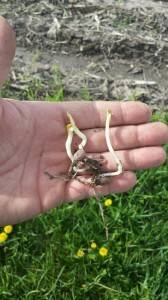
Sunshine and warm temperatures like we’ve experienced for the past week are definitely needed to push along emergence of recently planted seed. However, we’re starting to see some instances where seedlings are struggling to break through the crusted soil surface as a result of either conditions at planting time or heavy rainfalls afterwards.
Wet planting conditions, fine soil textures, intensive tillage, or heavy rains after planting can result in delayed or uniform emergence. Some seedlings may not even emerge at all, which lowers stand counts and may reduce overall yield. Another problem that can result from crusted soils is rootless corn. Roots will take the path of least resistance, which means they might grow out the bottom of the seed furrow.
To help break up the crust and improve seedling emergence, consider using a rotary hoe.Get off the tractor and check for stand loss when starting a field. If loss seems greater than 3 to 5 percent, you may want to slow your travel speed to be less aggressive with the tool. Take care so soybean cotyledons aren’t broken off by the hoe. Expect a minor stand loss from hoeing, but this should be insignificant if your crop is truly having difficulty breaking through a crust.
Be sure to wait until soils have dried before using a hoe, so you don’t exacerbate the situation with soil compaction. Use a quick field test to check soil moisture. Simply mold a length of soil between your index finger and thumb, or roll it into a ball in your hand. Observe whether the soil breaks apart as you work it. If you toss the ball of soil into the air and it shatters or cracks upon falling to the ground, then conditions are likely suitable for tillage.
